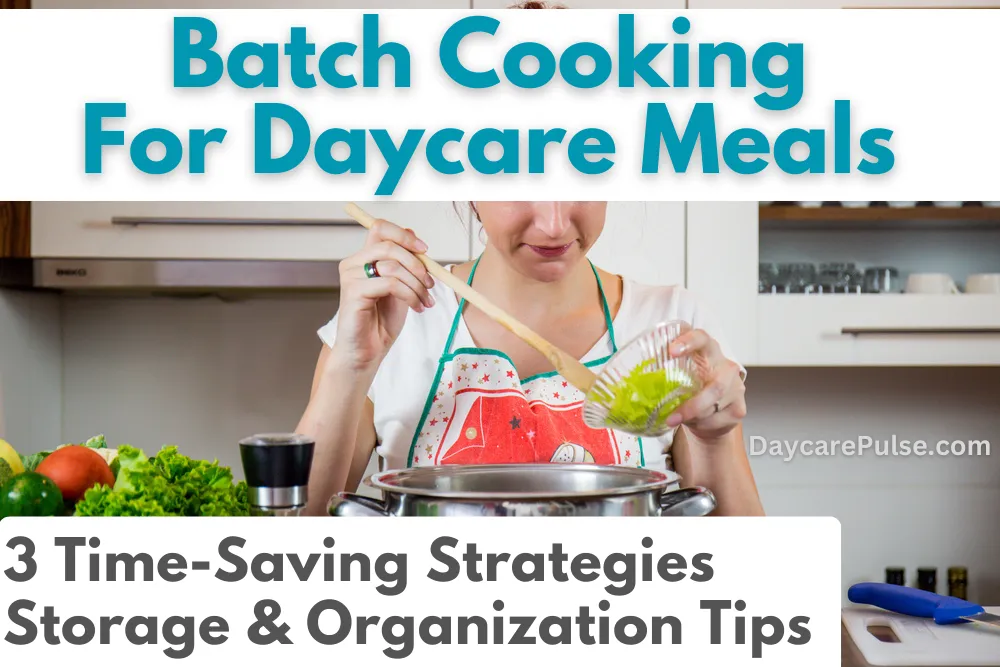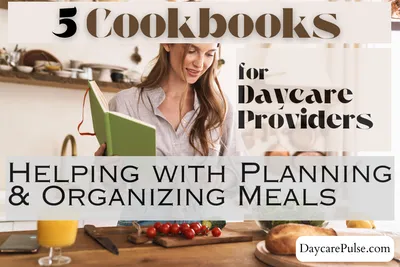Preparing nutritious, kid-friendly meals multiple times a day can quickly consume precious time, leaving you exhausted and stressed.
That’s where batch cooking comes in—a game-changer for home daycare providers looking to save time, reduce stress, and still serve delicious, healthy meals.
In this guide, you’ll learn practical & efficient cooking methods, storage & organization, making batch cooking easier for picky eaters & kids.
From easy meal planning and smart storage solutions to kid-approved recipes and efficient cooking hacks, we’ll cover everything you need to simplify your meal prep, cut down on waste, and free up your time—all while ensuring the little ones enjoy healthy, balanced meals every day.
Let’s dive into the magic of batch cooking and transform the way you handle daycare meals!

Planning & Organizing Daycare Meals For Batch Cooking
It’s 11:55 AM, the kids are getting restless, and lunch still isn’t ready. You glance at the fridge, wondering if you have enough to feed everyone.
Sound familiar?
I’ll walk you through 3 simple steps to make daycare meal planning easier such as planning your weekly menu, shopping efficiently in bulk, and prepping ingredients in advance.
By the end, you’ll have a smoother routine that saves you time and effort.
Let’s break this down into simple, practical strategies that will set you up for success.
1. Plan Your Weekly Menu — When you have a structured meal plan, you’re no longer scrambling at the last minute or staring into the fridge wondering what to make.
A great approach is to map out meals for the entire week. If planning seven days feels like too much, start with five.
Assigning these days makes it even easier—“Taco Tuesday,” “Pasta Wednesday,” “Breakfast-for-Lunch Friday”—so you’re not reinventing the wheel every week.
For example, cook a big batch of rice, roast a tray of vegetables, and pre-make protein portions that can be mixed and matched throughout the week.
2. Use Bulk Shopping to Save Time and Money — Buying in bulk isn’t just about saving money—it’s about making meal prep more efficient.
Stock up on staple ingredients like oats, rice, pasta, beans, frozen veggies, and proteins that can be used in multiple meals.
For example, a large bag of brown rice can be served with stir-fries, burrito bowls, and as a side dish throughout the week.
3. Pre-Cut and Prep Ingredients for the Week — One of the best ways to speed up meal prep is to get ingredients ready in advance.
Wash, peel, and chop vegetables, portion out proteins, and cook grains in bulk.
Store everything in airtight containers so meals come together effortlessly.
For example, slicing cucumbers and bell peppers in advance means you can grab them for a quick side dish or snack. Cooking and freezing ground turkey ahead of time allows you to throw together tacos or pasta in minutes.
A well-planned system allows you to focus more on engagement, learning, and creating a nurturing space.
Mealtime is a core part of the daycare experience, and when meals are thoughtfully planned, you create a smoother daily flow that keeps kids well-fed, engaged, and ready to learn.
What’s next?
Learning how to cook meals faster while keeping them nutritious and delicious! Let’s dive into efficient cooking methods for daycare kitchens.
3 Batch Cooking Methods For Daycare Meals
Do you ever feel like you're running a full-time restaurant instead of a daycare?
Let me introduce you to simple yet powerful ways to cook in large batches and freeze meals, portion control strategies make the most of one-pot meals to invest in appliances that make your life easier.
A cluttered, inefficient kitchen leads to stress, wasted time, and even wasted food.
When you optimize your cooking strategies, you create a smoother workflow that saves effort, reduces food waste, and ensures every meal is nutritious and stress-free.
1. Cook in Large Batches and Freeze Meals — Cooking in large batches isn’t just about saving time; it’s also about reducing stress and ensuring you always have healthy, homemade meals ready to go.
A freezer stocked with prepared meals means you’re never scrambling at the last minute.
Dishes that freeze well include:
- Homemade chicken nuggets – Prepare a big batch, freeze them on a tray, then store them in bags for easy grab-and-bake meals.
- Vegetable-packed pasta sauce – Make a large pot, portion it out, and freeze for quick pasta lunches.
- Turkey or chicken meatballs – These can be used in spaghetti, sandwiches, or even served as a finger food with a side of veggies.
- Soups and stews – Kid-friendly soups like lentil soup or mild chicken and rice soup freeze well and can be quickly reheated.
When freezing, portion meals in small containers or freezer bags labeled with the date. This way, you’re not defrosting more than you need, reducing waste and making mealtimes simple.
2. Include Portion Control — Serving meals in appropriate portions makes mealtime easier and more enjoyable for both you and the children.
One way to encourage kids to eat well without wasting food is by serving smaller portions first and offering seconds.
Another tip is using divided plates to create a balanced meal. If a child isn’t a fan of one food, they still have other options to choose from while being encouraged to try new flavors.
| Age Group | Grains & Carbs | Proteins (Meat/Beans) | Vegetables & Fruits | Dairy |
|---|---|---|---|---|
| 1-2 Years | ¼ cup rice/pasta | 1 oz chicken/beans | 2 tbsp cooked veggies | ½ cup milk |
| 3-4 Years | ½ cup rice/pasta | 1.5 oz meat/beans | ¼ cup cooked veggies | ½-¾ cup milk |
| 5+ Years | ¾ cup rice/pasta | 2 oz meat/beans | ½ cup veggies | ¾-1 cup milk |
Young children can get overwhelmed by a full plate, so starting with a small serving helps them enjoy their food at their own pace.
3. Make One-Pan Meals — If you want to spend less time cooking and cleaning up, one-pan meals are your best friend.
These meals require fewer dishes and less effort while still being nutritious and filling.
One-pan meals like sheet pan roasted chicken with sweet potatoes and green beans let you cook everything at once, cutting down on dishes.
Simply toss everything with a little olive oil and seasoning, bake, and serve.
Cooking in large batches and freezing meals, applying portion control strategies & making one-pot meals would help you spend less time in the kitchen and help streamline your tasks hence saving you a lot of time.
You can start the meal in the morning, let it simmer, and have lunch ready by the time the kids are hungry.
Storage & Organization: Keeping Meals Fresh & Accessible
How much time and money could you save if every meal ingredient was neatly stored, easy to access, and fresh when you needed it?
I’ll show you how to portion and store meals & safe food storage guidelines ensuring freshness and easy access while keeping your daycare kitchen stress-free.
By following safe food storage practices, you not only prevent spoilage but also protect the health of the children you care for, giving parents peace of mind.
The good news? With the right approach, even the pickiest eaters can learn to enjoy new foods. It just takes patience, consistency, and a little creativity.
1. Portion and Store Meals the Right Way — Portioning meals properly before storing them helps reduce waste, speed up serving time, and maintain food quality.
Instead of refrigerating a large container of soup or pasta and scooping portions throughout the week, pre-portioning meals ensures that you’re always serving the right amount without over-preparing.
The best storage methods include:
- Individual child-sized containers
- Silicone freezer trays
- Freezer-safe bags (flattened for easy stacking)
- Stackable, clear containers
Instead of making peanut butter and banana sandwiches every morning, prep them in advance.
Knowing how long different foods stay fresh helps with meal planning, budgeting, and food safety.
This guide ensures you’re always serving high-quality meals while avoiding waste.
| Food Item | Fridge (40°F or below) | Freezer (0°F or below) |
|---|---|---|
| Cooked Chicken/Turkey | 3–4 days | 2–3 months |
| Ground Beef/Turkey | 1–2 days | 3–4 months |
| Cooked Vegetables | 3–5 days | 10–12 months |
| Pasta/Rice (cooked) | 3–5 days | 1–2 months |
| Soups & Stews | 3–4 days | 2–3 months |
| Hard Cheese | 3–4 weeks | 6 months |
| Bread/Tortillas | 5–7 days | 3 months |
Keeping track of storage times ensures that meals stay safe and delicious for daycare children.
2. Safe Food Storage Guidelines
Food safety is a top priority in any daycare setting. Proper storage and handling prevent foodborne illnesses and ensure that every meal meets daycare licensing and health regulations.
Here are some key food safety guidelines every daycare provider should follow:
- Cool food properly before storing it – Allow cooked food to cool slightly before placing it in the fridge or freezer to avoid bacterial growth.
- Use shallow containers for quicker cooling – Large batches of food should be divided into smaller portions to speed up cooling and maintain quality.
- Label and date everything – This prevents guessing games when it’s time to reheat meals. If something has been in the fridge too long, it’s better to be safe and discard it.
- Store raw and cooked foods separately – Raw meats should be stored on the bottom shelf of the fridge to prevent juices from dripping onto ready-to-eat foods.
- Reheat food to the correct temperature – Meals should be reheated to 165°F to ensure they’re safe to eat.
- Never refreeze thawed food – Once food has thawed, use it within 24 hours or discard it.
Mastering efficient cooking methods means less stress, reduced waste, and more time for the children in your care.
By embracing batch cooking, time-saving appliances, portion control, and one-pot meals, you create a smoother, more organized kitchen that simplifies daily routines.
Now, it’s time to put these strategies into action!
Next, we’ll dive into Making Batch Cooking Easier for Picky Eaters & Kids, where you’ll learn how to store meals effectively, minimize waste, and keep your daycare kitchen running smoothly.
Making Batch Cooking Easier for Picky Eaters & Kids
You’ve spent time planning, prepping, and cooking meals in advance, only for the kids to take one bite and push the plate away. Sound familiar?
I’ll guide you through a simple step-by-step method such as Start with One Meal Type, Choose Three Simple Meals & Gradually Expand to Full-Week Meal Prep to introduce batch cooking in a way that picky eaters will accept.
I’ll help you build a daycare meal plan that works for both you and your little ones—without wasted food or power struggles.
Step 1: Start with One Meal Type (Breakfast, Lunch, or Snacks) — Jumping into full-scale batch cooking for picky eaters can feel overwhelming.
The best way to set yourself up for success is to start with just one meal type.
Breakfast, lunch, or snacks—choose whichever feels the easiest to prepare in bulk.
For many daycare providers, snacks are the easiest place to start.
Children tend to be more adventurous with snacks because they’re small, fun, and don’t feel like a “meal” where they have to sit for long periods.
An easy snack prep idea for example Make a big batch of whole wheat banana muffins and freeze them in portions. When snack time comes, just reheat and serve with fruit or yogurt.
Once you feel confident with batch prepping one type of meal, move on to the next.
Step 2: Choose Three Simple Meals to Repeat for the First Week — Introducing too many new foods at once can overwhelm picky eaters. Instead, stick to three simple meals that are nutritious, easy to prepare, and familiar to the kids.
If breakfast is the focus, here’s a simple meal rotation:
- Overnight oats with mashed banana and cinnamon
- Mini whole wheat pancakes (pre-made and frozen) served with fruit
- Scrambled eggs with whole grain toast and a side of apple slices
Having just three meal options takes the stress out of decision-making while allowing kids to build familiarity with the foods.
Repetition is key—the more children see the same food, the more comfortable they become with it.
For lunches, a simple batch cooking plan might include:
- Mild turkey and veggie pasta bake
- Cheese and veggie quesadillas with a side of black beans
- Chicken and rice with steamed carrots
Each meal can be prepped in bulk, stored in portions, and served throughout the week.
Step 3: Gradually Expand to Full-Week Meal Prep — Once the kids are adjusted to a few staple meals, start adding more variety.
Expanding from three meals to a full week’s worth of batch-prepped meals makes planning even easier.
 Tip: A helpful trick is introducing one new food at a time while keeping the rest of the meal familiar. Another trick is to offer meals in a way that allows kids to have some control over their plates.
For example, serving DIY taco bowls with separate ingredients like rice, beans, cheese, and mild salsa lets kids mix and match foods in a way that feels safe for them.
A child refuses roasted sweet potatoes? Try blending them into a mild sweet potato pancake.
Not a fan of plain chicken? Serve it with a fun dipping sauce like mild yogurt-based ranch or a little honey mustard.
Won’t eat cooked carrots? Offer them raw with hummus as a snack instead.
Mastering batch cooking for picky eaters is about consistency, variety, and ease.
Starting small, repeating simple meals, and expanding gradually reduces stress, minimizes food battles, and keeps kids happily fed.
Next, we’ll tackle reducing cleanup stress and increasing efficiency—because a smooth kitchen routine doesn’t end with batch cooking!
Reducing Cleanup Stress & Increase Cooking Efficiency
If your kitchen looks like a disaster zone after every meal, it's time to rethink your approach.
I'll show you three simple yet powerful strategies—cleaning as you cook, using liners and mats, and organizing with color-coded supplies.
Constant cleanup leads to exhaustion, taking away the joy of cooking and making meal prep feel like a chore instead of a time-saving tool so you will be able to help yourself cut down on kitchen mess without adding extra effort.
1. Clean as You Cook — A helpful trick is the “One-Minute Clean-Up Rule”—if a task takes less than a minute, do it right away.
Wipe a counter, rinse a cutting board, toss scraps in the trash—those small moments add up.
Professional chefs use a technique called mise en place—a fancy way of saying everything should be prepped and cleaned as you go.
Instead of leaving vegetable peels scattered all over the counter, keep a small bowl nearby to collect scraps and toss them in the trash or compost as you prep.
The same goes for used utensils—rinse them immediately instead of letting them pile up in the sink.
Another time-saver?
Fill the sink with warm, soapy water before you start cooking. That way, when you’re done using a pot or pan, it can go straight into the sink to soak, making cleanup much easier.
2. Use Liners and Mats — Cleaning sticky daycare tables is a daily battle, but a simple liner or mat can make a huge difference.
Instead of scrubbing down every surface multiple times a day, placing washable silicone mats under plates or using wipeable table liners catches spills before they become a problem.
For kitchen storage, liners in drawers and fridge shelves prevent food drips and crumbs from sticking to hard-to-clean surfaces.
Spilled juice or yogurt? Instead of scrubbing an entire fridge shelf, just pull out the liner, rinse it off, and put it back.
Baking sheets lined with parchment paper or silicone mats make oven cleanup much easier. Instead of scrubbing a pan covered in melted cheese or sauce, simply toss the liner away or wash the mat.
3. Color-Coded Supplies — When caring for multiple kids, keeping cleaning supplies organized and hygienic is just as important as making cleanup fast.
Color-coding is a simple yet effective way to stay on top of everything.
Using different colors for different tasks prevents cross-contamination and ensures everything is being used where it’s meant to be. A simple system like this works well:
| Cleaning Task | Color | Use |
|---|---|---|
| Table Cleaning | Green | Wiping down tables before and after meals |
| Dishwashing | Blue | Scrubbing and rinsing dishes |
| Countertops & Prep Areas | Red | Cleaning food prep areas to prevent contamination |
Color-coded bins for dirty and clean rags make it even easier to keep everything in order.
Instead of searching for a fresh cloth in a hurry, just grab the right color from the “clean” bin and toss the used one in the laundry.
Reducing cleanup stress isn’t just about saving time—it makes batch cooking more efficient and enjoyable.
A well-organized kitchen with simple strategies like cleaning as you cook or using liners ensures mealtime stays stress-free. Try these hacks today and see the difference!
Next, let’s explore the best kitchen tools that will make batch cooking even easier.s
Frequently Asked Questions
1. How Can I Keep Meals Fresh and Avoid Them Tasting “Leftover”?
One of the biggest worries with batch cooking is that meals might start to taste stale or dry out after storage.
The trick? Proper storage and reheating methods.
- Cool food before storing it
- Use airtight storage containers
- Reheat the right way
- Flash freeze when possible
2. What Foods Don’t Freeze Well and Should Be Avoided in Batch Cooking?
Some foods just don’t survive the freezer well—they can get mushy, grainy, or lose their flavor completely. Here are a few to watch out for:
| Foods That Don’t Freeze Well | Why? | Alternative Storage Method |
|---|
| Foods That Don’t Freeze Well | Why? | Alternative Storage Method |
|---|---|---|
| Lettuce, cucumbers, and raw greens | Become limp and watery | Store fresh and use within a few days |
| Cooked pasta (plain) | Turns mushy when thawed | Freeze pasta in sauce for better texture |
| Dairy-based sauces (like Alfredo) | May separate and become grainy | Use fresh or store in the fridge for short-term use |
| Fried foods (like crispy chicken) | Lose crunch and get soggy | Store breaded chicken raw and bake fresh |
| Potatoes (boiled or mashed) | Can become grainy and watery | Freeze mashed potatoes with butter and milk to retain texture |
| Hard-boiled eggs | Turn rubbery when frozen | Store in the fridge for up to a week instead |
Conclusion
Batch cooking is one of the best ways to reduce stress, save time, and keep daycare meals nutritious and organized.
By planning ahead, using the right storage techniques, and making small adjustments based on what works for your kids, you can serve fresh, homemade meals all week without feeling overwhelmed.
Try just ONE of these batch cooking hacks this week!
Whether it’s planning three simple meals, pre-portioning snacks, or testing out a new freezer storage method, see how it changes your routine.
Then, come back and share your experience—I’d love to hear what worked for you!




